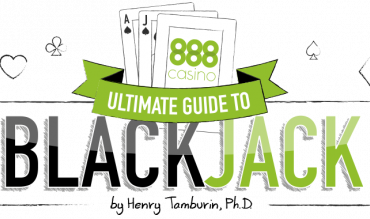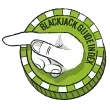BLACKJACK GLOSSARY
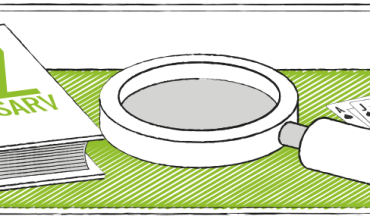

Ace. Can count as either 1 or 11. It is assumed that an ace in your hand counts as 11 unless your hand exceeds a count of 21 in which case the ace can revert to a count of 1.
Action. Refers to the total amount of money wagered on all your hands.
Advantage Player. A player who has the mathematical advantage over the casino.
Anchor Player. This is a term used to designate the player seated to the far left of the table (to the immediate right of the dealer). This is the last player to act before the dealer acts on his hand.
Action. Refers to the total amount of money wagered on all your hands.
Advantage Player. A player who has the mathematical advantage over the casino.
Anchor Player. This is a term used to designate the player seated to the far left of the table (to the immediate right of the dealer). This is the last player to act before the dealer acts on his hand.
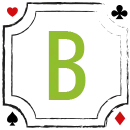
Back Counting. Technique where a player stands and watches a blackjack table without playing, while keeping the count with the intent of entering the game once the game becomes player favorable.
Backed Off. When a casino supervisor tells a player to stop playing.
Balanced Card Counting System. When the card counting tags for all the cards sum to zero.
Bankroll. The amount of money the player uses to gamble.
Barber Pole. A wager made by a player consisting of a pile of different-colored (i.e., denomination) chips.
Barring. When a casino supervisor tells a player that he is permanently prohibited from playing blackjack in the casino.
Basic Strategy. Set of playing decisions that are the mathematically optimal way to play each hand based solely on the player’s cards and the dealer’s upcard.
Bet Sizing. Sizing your bet in proportion to your mathematical advantage over the casino.
Bet Spread. The ratio of the maximum bet to minimum bet.
Betting Efficiency. The percent of the time a counting system will recognize when the player has an advantage for betting purposes.
Betting Ramp. The amount of money a card counter should wager at each value of the true count.
Betting Spot. Designated area on the layout in front of each player (either a square or circle) where each player places his wager (i.e., chips).
Big Player. A player who waits for a secret signal from a confederate card counter, and then enters the game and makes large bets.
Black Chips. Black-colored casino chips that usually have a value of $100.
Blackjack. A player’s first two cards consisting of an ace and a 10-value card.
Break. When a hand exceeds a count of 21.
Burn Card. After the decks of cards are shuffled and cut, it’s the first card that is removed by the dealer face and placed face down in the discard tray.
Bust. When a hand exceeds a count of 21.
Bust Card. A specific card that results in a player’s or dealer’s hand’s exceeding a count of 21.
Buy-In. The exchange of money for chips.
Backed Off. When a casino supervisor tells a player to stop playing.
Balanced Card Counting System. When the card counting tags for all the cards sum to zero.
Bankroll. The amount of money the player uses to gamble.
Barber Pole. A wager made by a player consisting of a pile of different-colored (i.e., denomination) chips.
Barring. When a casino supervisor tells a player that he is permanently prohibited from playing blackjack in the casino.
Basic Strategy. Set of playing decisions that are the mathematically optimal way to play each hand based solely on the player’s cards and the dealer’s upcard.
Bet Sizing. Sizing your bet in proportion to your mathematical advantage over the casino.
Bet Spread. The ratio of the maximum bet to minimum bet.
Betting Efficiency. The percent of the time a counting system will recognize when the player has an advantage for betting purposes.
Betting Ramp. The amount of money a card counter should wager at each value of the true count.
Betting Spot. Designated area on the layout in front of each player (either a square or circle) where each player places his wager (i.e., chips).
Big Player. A player who waits for a secret signal from a confederate card counter, and then enters the game and makes large bets.
Black Chips. Black-colored casino chips that usually have a value of $100.
Blackjack. A player’s first two cards consisting of an ace and a 10-value card.
Break. When a hand exceeds a count of 21.
Burn Card. After the decks of cards are shuffled and cut, it’s the first card that is removed by the dealer face and placed face down in the discard tray.
Bust. When a hand exceeds a count of 21.
Bust Card. A specific card that results in a player’s or dealer’s hand’s exceeding a count of 21.
Buy-In. The exchange of money for chips.

Camouflage. Techniques used by a card counter to disguise the fact the he is card counting.
Card Counter. A player who tracks specific cards as they are played to ascertain when the advantage shifts in his favor.
Cashier’s Cage. Area in a casino where a player converts casino chips into cash.
Casino Manager. Casino executive responsible for the operation of a casino.
Checks. Another name for casino chips.
Chip. The clay tokens used by casinos for players to make a wager.
Chip Counting. Determining the value of a stack of chips by eyeballing the stack, primarily in tournaments.
Chip Tray. The tray that sits in front of the dealer where the casino chips are kept and distributed by the dealer to players after they win a hand.
Color for Color. When a dealer pays off a winning bet with the same denomination chips as those wagered.
Color Up. To exchange smaller denomination chips for larger denomination chips at the table.
Comp. Complimentary (i.e., free) product or service offered by the casino to its loyal customers.
Continuous Shuffling Machine (CSM). An automatic shuffling machine that randomly mixes the discards in with the remaining cards after each round.
Correlate. Betting the same amount as an opponent in a blackjack tournament.
Count. The value of the count in card counting systems. As a verb, to count cards.
Countdown. When the casino counts all the chips of tournament players after a specified number of hands.
Currency Transaction Report (CTR). A report that casinos must fill out for any cash transactions exceeding $10,000 in a 24-hour period. This is mandated by the federal government.
Cut Card. A colored plastic card that a player inserts into the just-shuffled cards to determine where the dealer will cut the decks. When the cut card appears during a round, the round is completed, and then the cards are shuffled.
Cutoff. The unplayed cards that are behind the cut card in a dealing shoe.
Card Counter. A player who tracks specific cards as they are played to ascertain when the advantage shifts in his favor.
Cashier’s Cage. Area in a casino where a player converts casino chips into cash.
Casino Manager. Casino executive responsible for the operation of a casino.
Checks. Another name for casino chips.
Chip. The clay tokens used by casinos for players to make a wager.
Chip Counting. Determining the value of a stack of chips by eyeballing the stack, primarily in tournaments.
Chip Tray. The tray that sits in front of the dealer where the casino chips are kept and distributed by the dealer to players after they win a hand.
Color for Color. When a dealer pays off a winning bet with the same denomination chips as those wagered.
Color Up. To exchange smaller denomination chips for larger denomination chips at the table.
Comp. Complimentary (i.e., free) product or service offered by the casino to its loyal customers.
Continuous Shuffling Machine (CSM). An automatic shuffling machine that randomly mixes the discards in with the remaining cards after each round.
Correlate. Betting the same amount as an opponent in a blackjack tournament.
Count. The value of the count in card counting systems. As a verb, to count cards.
Countdown. When the casino counts all the chips of tournament players after a specified number of hands.
Currency Transaction Report (CTR). A report that casinos must fill out for any cash transactions exceeding $10,000 in a 24-hour period. This is mandated by the federal government.
Cut Card. A colored plastic card that a player inserts into the just-shuffled cards to determine where the dealer will cut the decks. When the cut card appears during a round, the round is completed, and then the cards are shuffled.
Cutoff. The unplayed cards that are behind the cut card in a dealing shoe.

DAS. Abbreviation for doubling after pair splitting.
Dealer. Casino employee that is responsible for dealing the cards at a blackjack table. (Ditto for other casino table games.)
Deck. Standard 52-card deck of cards.
Deck Penetration. The percentage of cards that is dealt before the shuffle.
Deviation. Changing from the basic strategy, based on the count.
Discards. The cards that were played in a round and placed in the discard tray. The cumulative collection of all such cards.
Discard Tray. A clear plastic device that holds all the cards that have been played.
DOA. Abbreviation for doubling on anything, meaning any initial two cards.
Doubling Down. After receiving the first two cards, a player has the option to make a secondary wager ager up to the original bet amount and receive only one additional draw card.
Down Card. Dealer’s hole card or any card that is dealt face down.
Drawing. The act of receiving another card to a hand.
Dealer. Casino employee that is responsible for dealing the cards at a blackjack table. (Ditto for other casino table games.)
Deck. Standard 52-card deck of cards.
Deck Penetration. The percentage of cards that is dealt before the shuffle.
Deviation. Changing from the basic strategy, based on the count.
Discards. The cards that were played in a round and placed in the discard tray. The cumulative collection of all such cards.
Discard Tray. A clear plastic device that holds all the cards that have been played.
DOA. Abbreviation for doubling on anything, meaning any initial two cards.
Doubling Down. After receiving the first two cards, a player has the option to make a secondary wager ager up to the original bet amount and receive only one additional draw card.
Down Card. Dealer’s hole card or any card that is dealt face down.
Drawing. The act of receiving another card to a hand.

Early Surrender. A player is allowed to surrender his hand (i.e., forfeit half of the bet) before the dealer checks if she has a blackjack.
Edge. The percentage of each bet that a player stands to win or lose.
Eighty-Six. Barring an individual from a casino.
Elimination Tournament. Blackjack tournament in which players with the most chips on each table after the tournament round advance to play at another table, while the remaining players are eliminated from the tournament.
Entry-Level Card Counting System. A simplified card counting system that is easier to learn and use but with less power than a traditional card counting system.
Even Money. When a player has a blackjack and the dealer has an ace upcard, the dealer will offer the player an even-money payoff, before she peeks at her down card, which is equivalent to the player’s taking insurance.
Expectation. What a player can expect to win or lose in the long run.
Eye in the Sky (EITS). The cameras, usually in glass bubbles, located on the ceiling in casinos, that record all the action for surveillance personnel to monitor.
Edge. The percentage of each bet that a player stands to win or lose.
Eighty-Six. Barring an individual from a casino.
Elimination Tournament. Blackjack tournament in which players with the most chips on each table after the tournament round advance to play at another table, while the remaining players are eliminated from the tournament.
Entry-Level Card Counting System. A simplified card counting system that is easier to learn and use but with less power than a traditional card counting system.
Even Money. When a player has a blackjack and the dealer has an ace upcard, the dealer will offer the player an even-money payoff, before she peeks at her down card, which is equivalent to the player’s taking insurance.
Expectation. What a player can expect to win or lose in the long run.
Eye in the Sky (EITS). The cameras, usually in glass bubbles, located on the ceiling in casinos, that record all the action for surveillance personnel to monitor.

Face-Down Game. A blackjack game where the initial two cards dealt to players are face down.
Face-Up Game. A blackjack game where the initial two cards dealt to players are face up (and players are not allowed to handle the cards).
First Base. The first seat at a blackjack table located on the dealer’s far left side; this player is the first to act on his hand.
Flasher. A dealer who inadvertently exposes her down card to players.
Flat Bet. Betting the same amount of money on successive hands.
Floorperson. Casino supervisor, located in the pit, who is responsible for supervising a group of tables.
Front Money. Money that a player deposits at the cashier cage and then uses to draw markers.
Face-Up Game. A blackjack game where the initial two cards dealt to players are face up (and players are not allowed to handle the cards).
First Base. The first seat at a blackjack table located on the dealer’s far left side; this player is the first to act on his hand.
Flasher. A dealer who inadvertently exposes her down card to players.
Flat Bet. Betting the same amount of money on successive hands.
Floorperson. Casino supervisor, located in the pit, who is responsible for supervising a group of tables.
Front Money. Money that a player deposits at the cashier cage and then uses to draw markers.

Greens. A green-colored chip usually valued at $25.
Going for the High. Betting a sufficient number of chips in a tournament so that if all players win the hand, the player will end up with the most chips.
Going for the Low. Holding back one more chip that the competitors’ unbet stack of chips in a tournament (and hoping the dealer beats the table).
Going for the High. Betting a sufficient number of chips in a tournament so that if all players win the hand, the player will end up with the most chips.
Going for the Low. Holding back one more chip that the competitors’ unbet stack of chips in a tournament (and hoping the dealer beats the table).

Hand. The cards that are dealt to a player or the dealer.
Hand-Held Game. A blackjack game (usually single- and double-deck deck) where the dealer holds the cards in her hand rather than placing them in a dealing shoe.
Hard Hand. A hand that either has no ace, or if an ace is present, it counts as one (rather than eleven).
Hand-Spreading. Increasing the number of simultaneous hands per round that a card counter plays when the edge shifts in his favor.
Heads Up. Playing alone against a dealer.
Heat. When casino personnel carefully scrutinize a player while he is playing.
High Roller. Player who makes large wagers.
Hi-Lo. Popular balanced card counting system.
Hit. When a player requests another card or, when by the rules, the dealer must draw another card.
Hit 17 (h27). A rule requiring the dealer to hit all her totals of 17, including soft 17.
Hole Card. The card in the dealer’s hand that is dealt face down.
Host. Casino employee that caters to players who wager a significant amount of money in a casino.
House. Another term for casino.
House Edge. The percentage of the money wagered by a player that the casino theoretically expects to win (or lose).
Hand-Held Game. A blackjack game (usually single- and double-deck deck) where the dealer holds the cards in her hand rather than placing them in a dealing shoe.
Hard Hand. A hand that either has no ace, or if an ace is present, it counts as one (rather than eleven).
Hand-Spreading. Increasing the number of simultaneous hands per round that a card counter plays when the edge shifts in his favor.
Heads Up. Playing alone against a dealer.
Heat. When casino personnel carefully scrutinize a player while he is playing.
High Roller. Player who makes large wagers.
Hi-Lo. Popular balanced card counting system.
Hit. When a player requests another card or, when by the rules, the dealer must draw another card.
Hit 17 (h27). A rule requiring the dealer to hit all her totals of 17, including soft 17.
Hole Card. The card in the dealer’s hand that is dealt face down.
Host. Casino employee that caters to players who wager a significant amount of money in a casino.
House. Another term for casino.
House Edge. The percentage of the money wagered by a player that the casino theoretically expects to win (or lose).
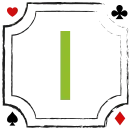
Illustrious 18. Group of eighteen card counting indices that result in achieving about 80%90% of the gain available in varying the playing strategy based on the count.
Index Number. The value of the true count at which a card counter would deviate from basic strategy for a particular hand.
Insurance. A side bet that the dealer has a blackjack. Players may make the insurance bet (equal to a maximum of half of the original amount wagered on the hand) when the dealer’s upcard is an ace. If the dealer has a blackjack, the insurance bet is paid at 2-1.
Index Number. The value of the true count at which a card counter would deviate from basic strategy for a particular hand.
Insurance. A side bet that the dealer has a blackjack. Players may make the insurance bet (equal to a maximum of half of the original amount wagered on the hand) when the dealer’s upcard is an ace. If the dealer has a blackjack, the insurance bet is paid at 2-1.

Kelly Betting. A technique for betting that optimizes logarithmic bankroll growth while minimizing risk.

Late Surrender. A player is allowed to surrender his hand (i.e., forfeit half of the bet) after the dealer checks if she has a blackjack.
Lifetime Risk of Ruin. An amount of money a player should set aside to play a lifetime of blackjack with minimum risk of ruin (often set at 5 percent or less).
Live-Money Tournament. A tournament in which the players must purchase chips used in betting during the tournament round.
Long Term. The more you play, the more likely your actual results will be closer, percentagewise, to your expected results.
Lifetime Risk of Ruin. An amount of money a player should set aside to play a lifetime of blackjack with minimum risk of ruin (often set at 5 percent or less).
Live-Money Tournament. A tournament in which the players must purchase chips used in betting during the tournament round.
Long Term. The more you play, the more likely your actual results will be closer, percentagewise, to your expected results.

Marker. A bank draft, legally equivalent to an enforceable debt (IOU), signed by a player who is requesting chips.
Martingale. A progressive betting system in which a player often doubles his wager after a loss, and then returns to his initial bet following a win.
Mid-Shoe Entry. Entering a game and making a bet after the first round (following the shuffle) is completed up to when the cut card appears. Money Plays. Term used to alert the dealer and the pit staff that a player is going to wager in cash rather than casino chips.
Multi-Parameter System. A card counting system that keeps tracks of two different counts, usually the main running count and another side count of aces.
Martingale. A progressive betting system in which a player often doubles his wager after a loss, and then returns to his initial bet following a win.
Mid-Shoe Entry. Entering a game and making a bet after the first round (following the shuffle) is completed up to when the cut card appears. Money Plays. Term used to alert the dealer and the pit staff that a player is going to wager in cash rather than casino chips.
Multi-Parameter System. A card counting system that keeps tracks of two different counts, usually the main running count and another side count of aces.

Natural. Another term for a blackjack.
Negative Count. When the count is below zero, and the game is in the casino’s favor.
Nickels. Red-colored casino chips usually valued at $5.
Negative Count. When the count is below zero, and the game is in the casino’s favor.
Nickels. Red-colored casino chips usually valued at $5.

Paint. Any picture card.
Pair Splitting. Option that allows a player to split the initial two-card hand containing a pair into two hands. The player must make a secondary wager equal to the initial wager when pair splitting.
Pat Hand. A hand that totals 17 through 21 that doesn’t require a hit.
Peeker. An optical device embedded in the table that the dealer uses to determine whether her down card is a ten-value card or an ace (meaning the dealer is starting off with a blackjack, and therefore the round is over). If the peeker doesn't register a ten-value card or ace, play continues.
Penetration (Pen). The percentage of cards that the dealer deals before shuffling.
Pit Boss. A supervisor of table games. Pitch. The method used by the dealer to deal the cards to players, usually in single- and double-deck games.
Play Variation. A deviation from basic playing strategy, based on the count, used by card counters.
Ploppy. Slang term for a player who is clueless regarding the basic playing strategy.
Positive Count. When the count is greater than zero and the game is often in the player’s favor.
Progressive Betting. A system of betting based on whether the current hand wins or loses.
Push. A final player’s hand with the same total as the dealer’s final hand. This is a “tie,” so the chips you wagered on the hand stay where they are in the betting spot.
Pair Splitting. Option that allows a player to split the initial two-card hand containing a pair into two hands. The player must make a secondary wager equal to the initial wager when pair splitting.
Pat Hand. A hand that totals 17 through 21 that doesn’t require a hit.
Peeker. An optical device embedded in the table that the dealer uses to determine whether her down card is a ten-value card or an ace (meaning the dealer is starting off with a blackjack, and therefore the round is over). If the peeker doesn't register a ten-value card or ace, play continues.
Penetration (Pen). The percentage of cards that the dealer deals before shuffling.
Pit Boss. A supervisor of table games. Pitch. The method used by the dealer to deal the cards to players, usually in single- and double-deck games.
Play Variation. A deviation from basic playing strategy, based on the count, used by card counters.
Ploppy. Slang term for a player who is clueless regarding the basic playing strategy.
Positive Count. When the count is greater than zero and the game is often in the player’s favor.
Progressive Betting. A system of betting based on whether the current hand wins or loses.
Push. A final player’s hand with the same total as the dealer’s final hand. This is a “tie,” so the chips you wagered on the hand stay where they are in the betting spot.
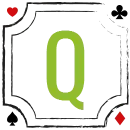
Quarters. Green-colored $25 denomination chips.
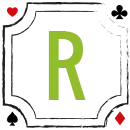
Reds. Red-colored chips valued at $5.
Resplits. Allowing a player to split a pair, after an initial split, usually up to three or four hands.
Risk of Ruin. The chance of a player’s losing his entire bankroll.
Running Count. Cumulative arithmetic sum of the tags of all the cards dealt as of the moment of reckoning.
Rule of Six. In single-deck games, method of determining the number of rounds dealt before the shuffle, which would equal six minus the number of players currently at the table.
Resplits. Allowing a player to split a pair, after an initial split, usually up to three or four hands.
Risk of Ruin. The chance of a player’s losing his entire bankroll.
Running Count. Cumulative arithmetic sum of the tags of all the cards dealt as of the moment of reckoning.
Rule of Six. In single-deck games, method of determining the number of rounds dealt before the shuffle, which would equal six minus the number of players currently at the table.

Session Bankroll. Amount of bankroll the player sets aside for a single session of play.
Shoe. A device used to hold usually four or more decks of cards from which the dealer deals the cards.
Sit and Go. Fast blackjack tournaments that are usually offered on internet sites.
Soft 17 (S17). A rule requiring the dealer to stand on all her totals of 17, including soft 17.
Soft Hand. Any blackjack hand that contains an ace counted as 11.
Stand. Decision made by a player not to receive any more cards (or the casino rule that requires the dealer not to draw any more cards to her hand).
Standard Deviation. A mathematical term indicating the variability (dispersion) of results around the average result, which is indicative of risk.
Stiff Hand. A hard hand that totals 12 through 16. Suits. Casino executives — usually a floor person, shift supervisor, or pit boss. Surrender. A rule that allows a player to give up his initial hand and forfeit half of his wager.
Shoe. A device used to hold usually four or more decks of cards from which the dealer deals the cards.
Sit and Go. Fast blackjack tournaments that are usually offered on internet sites.
Soft 17 (S17). A rule requiring the dealer to stand on all her totals of 17, including soft 17.
Soft Hand. Any blackjack hand that contains an ace counted as 11.
Stand. Decision made by a player not to receive any more cards (or the casino rule that requires the dealer not to draw any more cards to her hand).
Standard Deviation. A mathematical term indicating the variability (dispersion) of results around the average result, which is indicative of risk.
Stiff Hand. A hard hand that totals 12 through 16. Suits. Casino executives — usually a floor person, shift supervisor, or pit boss. Surrender. A rule that allows a player to give up his initial hand and forfeit half of his wager.

Third Base. Last player to act before the dealer. (Also known as anchor player.)
Toke. A tip for the dealer.
Trespassed. When a casino executive “trespasses” a player, he is not allowed on the premises anymore and risks being arrested if he returns.
True Count. The running count divided by the number of remaining decks of cards.
Toke. A tip for the dealer.
Trespassed. When a casino executive “trespasses” a player, he is not allowed on the premises anymore and risks being arrested if he returns.
True Count. The running count divided by the number of remaining decks of cards.

Unbalanced Card Counting System. When the card counting tags for all the cards do not sum to zero.
Upcard. The card in the dealer’s initial two-card hand that is dealt face up.
Upcard. The card in the dealer’s initial two-card hand that is dealt face up.
Written by Henry Tamburin Ph.D.
